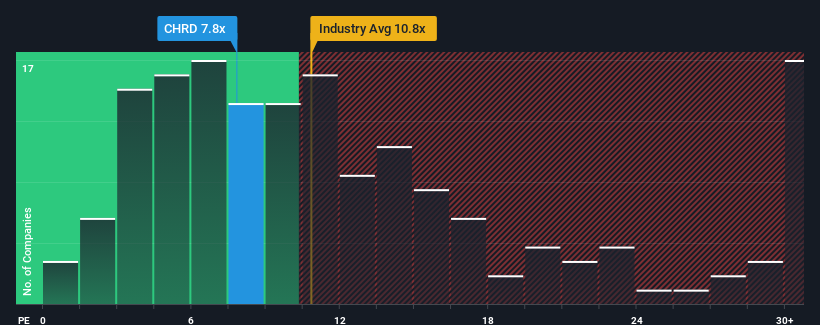- United States
- /
- Oil and Gas
- /
- NasdaqGS:CHRD
Chord Energy Corporation's (NASDAQ:CHRD) Earnings Are Not Doing Enough For Some Investors

Chord Energy Corporation's (NASDAQ:CHRD) price-to-earnings (or "P/E") ratio of 7.8x might make it look like a strong buy right now compared to the market in the United States, where around half of the companies have P/E ratios above 18x and even P/E's above 32x are quite common. Nonetheless, we'd need to dig a little deeper to determine if there is a rational basis for the highly reduced P/E.
Chord Energy has been struggling lately as its earnings have declined faster than most other companies. The P/E is probably low because investors think this poor earnings performance isn't going to improve at all. You'd much rather the company wasn't bleeding earnings if you still believe in the business. Or at the very least, you'd be hoping the earnings slide doesn't get any worse if your plan is to pick up some stock while it's out of favour.
Check out our latest analysis for Chord Energy

How Is Chord Energy's Growth Trending?
There's an inherent assumption that a company should far underperform the market for P/E ratios like Chord Energy's to be considered reasonable.
Retrospectively, the last year delivered a frustrating 54% decrease to the company's bottom line. However, a few very strong years before that means that it was still able to grow EPS by an impressive 1,469% in total over the last three years. Accordingly, while they would have preferred to keep the run going, shareholders would probably welcome the medium-term rates of earnings growth.
Looking ahead now, EPS is anticipated to climb by 2.1% each year during the coming three years according to the six analysts following the company. Meanwhile, the rest of the market is forecast to expand by 9.9% per year, which is noticeably more attractive.
With this information, we can see why Chord Energy is trading at a P/E lower than the market. Apparently many shareholders weren't comfortable holding on while the company is potentially eyeing a less prosperous future.
What We Can Learn From Chord Energy's P/E?
It's argued the price-to-earnings ratio is an inferior measure of value within certain industries, but it can be a powerful business sentiment indicator.
As we suspected, our examination of Chord Energy's analyst forecasts revealed that its inferior earnings outlook is contributing to its low P/E. At this stage investors feel the potential for an improvement in earnings isn't great enough to justify a higher P/E ratio. It's hard to see the share price rising strongly in the near future under these circumstances.
Before you settle on your opinion, we've discovered 2 warning signs for Chord Energy that you should be aware of.
If these risks are making you reconsider your opinion on Chord Energy, explore our interactive list of high quality stocks to get an idea of what else is out there.
New: AI Stock Screener & Alerts
Our new AI Stock Screener scans the market every day to uncover opportunities.
• Dividend Powerhouses (3%+ Yield)
• Undervalued Small Caps with Insider Buying
• High growth Tech and AI Companies
Or build your own from over 50 metrics.
Have feedback on this article? Concerned about the content? Get in touch with us directly. Alternatively, email editorial-team (at) simplywallst.com.
This article by Simply Wall St is general in nature. We provide commentary based on historical data and analyst forecasts only using an unbiased methodology and our articles are not intended to be financial advice. It does not constitute a recommendation to buy or sell any stock, and does not take account of your objectives, or your financial situation. We aim to bring you long-term focused analysis driven by fundamental data. Note that our analysis may not factor in the latest price-sensitive company announcements or qualitative material. Simply Wall St has no position in any stocks mentioned.
About NasdaqGS:CHRD
Chord Energy
Operates as an independent exploration and production company in the United States.
Good value with adequate balance sheet and pays a dividend.
Similar Companies
Market Insights
Community Narratives



